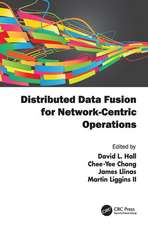Malware Diffusion Models for Modern Complex Networks: Theory and Applications
Autor Vasileios Karyotis, M.H.R. Khouzanien Limba Engleză Paperback – 2 feb 2016
Sections include a systematic introduction to malware diffusion processes in computer and communications networks, an analysis of the latest state-of-the-art malware diffusion modeling frameworks, such as queuing-based techniques, calculus of variations based techniques, and game theory based techniques, also demonstrating how the methodologies can be used for modeling in more general applications and practical scenarios.
- Presents a timely update on malicious software (malware), a serious concern for all types of network users, from laymen to experienced administrators
- Systematically introduces malware diffusion processes, providing the relevant mathematical background
- Discusses malware modeling frameworks and how to apply them to complex wireless networks
- Provides guidelines and directions for extending the corresponding theories in other application domains, demonstrating such possibility by using application models in information dissemination scenarios
Preț: 458.54 lei
Preț vechi: 678.28 lei
-32% Nou
Puncte Express: 688
Preț estimativ în valută:
87.74€ • 93.83$ • 73.16£
87.74€ • 93.83$ • 73.16£
Carte tipărită la comandă
Livrare economică 10-24 aprilie
Preluare comenzi: 021 569.72.76
Specificații
ISBN-13: 9780128027141
ISBN-10: 0128027142
Pagini: 324
Dimensiuni: 191 x 235 x 15 mm
Greutate: 0.66 kg
Editura: ELSEVIER SCIENCE
ISBN-10: 0128027142
Pagini: 324
Dimensiuni: 191 x 235 x 15 mm
Greutate: 0.66 kg
Editura: ELSEVIER SCIENCE
Cuprins
Part 1. Malware diffusion modeling framework
Chapter 1. Fundamentals of complex communications networks
Chapter 2. Malware diffusion in wired and wireless complex networks
Chapter 3. Early malware diffusion modeling methodologies
Part 2. State-of-the-art malware modeling frameworks
Chapter 4. Queuing-based malware diffusion modeling
Chapter 5. Malware-propagative Markov random fields
Chapter 6. Optimal control based techniques
Chapter 7. Game-theoretic techniques
Chapter 8. Qualitative comparison
Part 3. Applications and the road ahead
Chapter 9. Applications of state-of-the-art malware modeling frameworks
Chapter 10. The road ahead
Chapter 11. Conclusions
Part 4. Appendices
Appendix A. Systems of ordinary differential equations
Appendix B. Elements of queuing theory and queuing networks
Appendix C. Optimal control theory and Hamiltonians
Chapter 1. Fundamentals of complex communications networks
Chapter 2. Malware diffusion in wired and wireless complex networks
Chapter 3. Early malware diffusion modeling methodologies
Part 2. State-of-the-art malware modeling frameworks
Chapter 4. Queuing-based malware diffusion modeling
Chapter 5. Malware-propagative Markov random fields
Chapter 6. Optimal control based techniques
Chapter 7. Game-theoretic techniques
Chapter 8. Qualitative comparison
Part 3. Applications and the road ahead
Chapter 9. Applications of state-of-the-art malware modeling frameworks
Chapter 10. The road ahead
Chapter 11. Conclusions
Part 4. Appendices
Appendix A. Systems of ordinary differential equations
Appendix B. Elements of queuing theory and queuing networks
Appendix C. Optimal control theory and Hamiltonians













